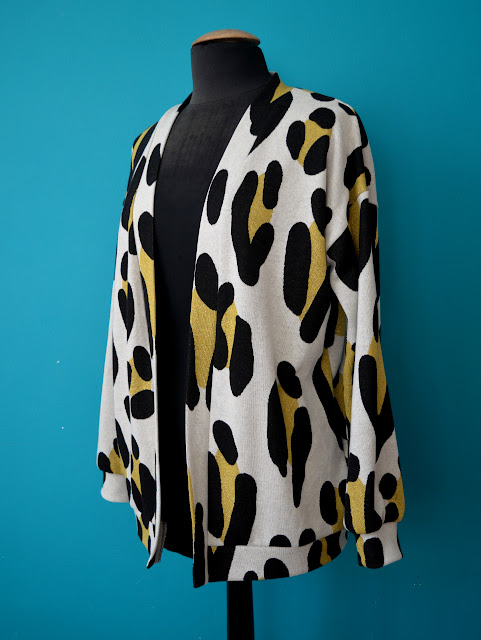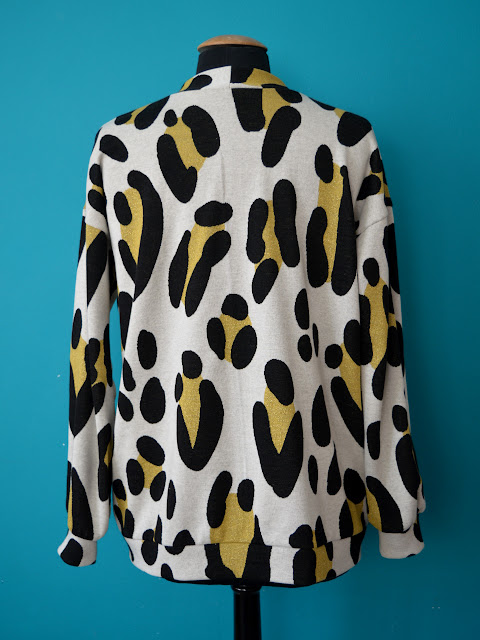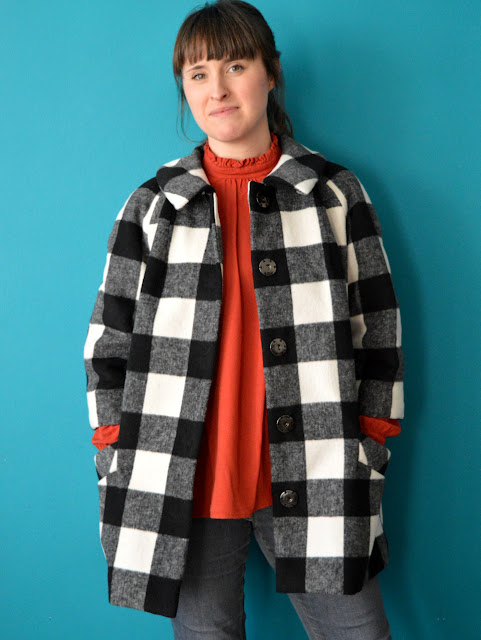Right, I hope you're sitting comfortably because I've got a lot to say about this project. First up, I feel I need to get this out of the way: I'm not sure that I like this top, or if I'll get much wear from it. But, that atypically doesn't bother me about this project. I'm trying to be as sustainable in my sewing as possible, so usually making a well-made, well-fitting garment that will have a long life and sees lots of use is the ultimate goal. However, this top is the product of two different trains of thought, and going on those little 'journeys' were more important and useful to me than if I'll wear this particular garment very much.
On to these two trains of thought. The first one was to scratch an itch that I've had to try piecing together scraps and leftovers of fabric and use them to make a wearable garment, without (fingers crossed) it looking like a quilt. I've been collecting inspiration on this Pinterest board, and paying particular attention to Lauren from Elbe Textile's amazing pieced-together creations on her IG account (@elbe_textiles). When I found that Lauren had written an excellent blog post about how she approaches patchwork clothing projects, I got the push I needed to finally give it a go.
I feel really strongly that everyone who is lucky enough to be living comfortably in a developed nation should try to reduce the amount of textile waste we are each responsible for. And that includes us sewers/sewists who make some, or all, of our own clothes. According to Patrick Grant on the GBSB, up to a third of the fabric we buy for each sewing project gets wasted. This is, of course, a higher percentage per garment than a mass produced item, which, in terms of textile waste, kind of takes the sheen off my smugness about shunning fast fashion! Like a lot of sewers who are interested in slow-sewing, my goal is to buy fewer pieces of fabric, but of a higher quality. And finding ways to utilise more than two-thirds of those lengths of fabric is of growing importance.
But I don't want to be wasting my sewing time, or those pieces of leftover fabric, making random accessories or homeware items: sewing for the sake of it just to feel that I used up as much of my fabric as I could. My main passion is garment sewing, and I've used scraps and leftovers a lot for making kids' clothes previously. However, not all my scraps lend themselves to children's wear, nor do my kids need lots of scrap-busting new clothes all the time. So the time has come for me to explore combining scraps and leftovers within adult garment projects.
The second train of thought that this project helped me work through, was a sense of low-level frustration caused by the feeling that that my sewing is not actually very creative. Most of my sewing projects follow this formula: match a piece of fabric with a sewing pattern that someone else has designed, then make a couple of tweaks to improve the fit, and rely on the instructions, plus my sewing-muscle memory, to achieve a nice finish. Then I parade the finished garment about IRL, and share it on my blog and Instagram feed, and usually enjoy receiving a few nice comments about it (because, like most people, I'm an approval junky). Yet I've been feeling that my involvement in the success of the garment is somewhat limited, and seeing as sewing is my main form of expression, that's pretty depressing. So this project was also about being more deeply involved in the look of my finished garment; by semi-creating the fabric that I cut the pattern pieces from, I was ensuring that I got a garment that was entirely unique.
So for those who may be interested, here's how I approached this project on a practical level. First, I took out all my scraps and leftovers, and put them in groups according to fabric type. The result of that produced two decent piles: one of leftover viscose fabrics, and another of cotton lawn type leftovers. I was more keen to use the viscose pieces, as generally they are less useful for pocket bags, facings, hankies and such. I found that four of the pieces combined made a nice teal/rust, shades-of-autumn-y colour story. Next, I took Lauren's advise and cut them into random squares and rectangles using a set square and rotary cutter, being as mindful as possible of the grainlines.
I picked the Scout tee pattern by Grainline Studio to use because, having made several before, I know that the fit is lovely and pairs well with other pieces in my wardrobe (I wear this one all the time in the summer). Plus, it'd provide a good, plain canvas for some (potentially-bonkers) patchwork fabric. I played around with positioning the rectangles together to make a big enough shapes to fit the front and back pattern pieces on. It look a long time, mainly because I was working with a very limited amount of fabric, and it involved quite a bit of recutting and rejigging. I stitched the shapes together using a 1cm seam allowance. but decided to use my pinking sheers rather than overlocker to finish the raw edges to A) save time, and B) reduce the bulk created by the seams. Squeezing the sleeve shapes out of the last of the fabric scraps was a real challenge.
I wish I'd taken a photograph, but at the end of this project, I was virtually left with dust! That was intensely pleasing, seeing as one of the motivators for this project was to use up dormant, seemingly-unusable pieces of fabric. In the same vein, I kind of view this garment as a 'free project', because I associate the cost of these fabrics with the original garment projects. In a sense, I've created value from a pile of weird-shaped scraps that otherwise no longer held value. This project was also the epitome of slow-sewing, because a 'regular' Scout tee project from virgin fabric would usually take me an evening to make, whereas this took the best part of a week's worth of pockets of sewing time.
As I say, I don't know if I'll wear this top very much, although I definitely plan to give a good run when the weather warms up in the hope that I fall in love with it. One of the reasons that I do want to wear it a lot, is that I hope it sparks thoughts, and even conversations, about waste and repurposing within sewing, and perhaps more broadly. I want it, in some small way, to contribute to a sea-change in how we view and behave towards the materials we consume. At the very least, I hope that a few of the people who come to my sewing classes, and anyone else who sews and happens to see me IRL, get inspired to hold on to their leftovers (if they have the space), and get creative with how they use them in the future.
Have you tried to make patchwork clothing? Have you seen anyone IRL or on the internet who has done so particularly successfully, in your opinion? Please tell all!





























